Efficacy of Synthetic Furanones on Listeria monocytogenes Biofilm Formation
Abstract
:1. Introduction
2. Materials and Methods
2.1. Origin of L. monocytogenes Isolates
2.2. L. monocytogenes RAPD-PCR Subtyping
2.3. L. monocytogenes Biofilms Growth
2.4. Plate Count Assays
2.4.1. Adhered Viable and Cultivable (AVC) Cells Quantification
2.4.2. Planktonic Viable Cells Quantification
2.5. Biofilm Inhibition Assays
2.5.1. Furanones’ Effects Screening
2.5.2. Effects of Fn1 and Fn3 Dosed at Different Concentrations on L34 Biofilm Formation and Planktonic Cell Growth
2.5.3. Epifluorescence Microscopy Assays
2.5.4. Effects of Fn3 Dosed at Different Times of L34 Biofilm Maturation
- -
- First, an addition of Fn3 to 9 coupons at t = 0 h with subsequent AVC sampling at 24, 48 and 72 h (n = 3 coupons per sampling time). This triple sampling was intended to better monitor the capability of Fn3 to inhibit the initial biofilm formation and the effects of a single dosage after 72 h.
- -
- Second, an addition of Fn3 to 3 coupons at t = 24 h with subsequent AVC sampling at 96. In this case, the sampling was intended to ascertain the antibiofilm effect of Fn3 on L. monocytogenes L34 early-stage biofilm by an end-point measurement 72 h after the furanone was added to the culture.
- -
- Finally, an addition of Fn3 to 3 coupons at t = 96 h followed by subsequent AVC sampling at 168 h. On this occasion, the assay was focused on the determination of the biofilm inhibitory effects of Fn3 applied on mature structures also by an end-point sampling 72 h after the addition of the furanone.
2.6. Statistical Analysis
3. Results
3.1. Subtyping
3.2. AVC Quantification in Early- and Late-Stage Biofilms on SS
3.3. Effect of Synthetic Furanones on L. monocytogenes Adhesion onto SS Coupons
3.4. Effect of Halogenated Furanones on L34 on Adhesion and Planktonic Cell Growth
3.5. Effects of F3 Early- and Mid-Term Dosage on L34 Biofilm Development
4. Discussion
5. Conclusions
Supplementary Materials
Author Contributions
Funding
Acknowledgments
Conflicts of Interest
References
- Carpentier, B.; Cerf, O. Review—Persistence of Listeria monocytogenes in food industry equipment and premises. Int. J. Food Microbiol. 2011, 145, 1–8. [Google Scholar] [CrossRef] [PubMed]
- Hall-Stoodley, L.; Costerton, J.; Stoodley, P. Bacterial biofilms: From the natural environment to infectious diseases. Nat. Rev. Microbiol. 2004, 2, 95–108. [Google Scholar] [CrossRef] [PubMed]
- Camargo, A.C.; de Paula, O.A.L.; Todorov, S.D.; Nero, L.A. In Vitro Evaluation of Bacteriocins Activity Against Listeria monocytogenes Biofilm Formation. Appl. Biochem. Biotechnol. 2016, 178, 1239–1251. [Google Scholar] [CrossRef] [PubMed]
- EFSA. ECDC The European Union summary report on trends and sources of zoonoses, zoonotic agents and food-borne outbreaks in 2017. EFSA J. 2018, 16, 5500. [Google Scholar]
- Vázquez-boland, J.A.; Kuhn, M.; Berche, P.; Chakraborty, T.; Domi, G.; González-zorn, B.; Wehland, J. Listeria Pathogenesis and Molecular Virulence Determinants. Clin. Microbiol. Rev. 2001, 14, 584–640. [Google Scholar] [CrossRef] [Green Version]
- Freitag, N.E.; Port, G.C.; Miner, M.D. Listeria monocytogenes—From saprophyte to intracellular pathogen. Nat. Rev. Microbiol. 2009, 7, 623–628. [Google Scholar] [CrossRef]
- European Centre for Disease Prevention and Control. Multi-Country Outbreak of Listeria Monocytogenes PCR Serogroup IVb MLST ST6—6 December 2017; ECDC: Stockholm, Sweden, 2017. [Google Scholar]
- World Health Organization WHO Congratulates South Africa on the End of the World’s Largest Listeriosis Outbreak. Available online: https://afro.who.int/news/who-congratulates-south-africa-end-worlds-largest-listeriosis-outbreak-0 (accessed on 24 November 2019).
- Smith, A.M.; Tau, N.P.; Smouse, S.L.; Allam, M.; Ismail, A.; Ramalwa, N.R.; Disenyeng, B.; Ngomane, M.; Thomas, J. Outbreak of Listeria monocytogenes in South Africa, 2017–2018: Laboratory Activities and Experiences Associated with Whole-Genome Sequencing Analysis of Isolates. Foodborne Pathog. Dis. 2019, 16, 524–530. [Google Scholar] [CrossRef] [Green Version]
- Belval, S.C.; Gal, L.; Margiewes, S.; Garmyn, D.; Piveteau, P.; Guzzo, J. Assessment of the roles of LuxS, S-ribosyl homocysteine, and autoinducer 2 in cell attachment during biofilm formation by Listeria monocytogenes EGD-e. Appl. Environ. Microbiol. 2006, 72, 2644–2650. [Google Scholar] [CrossRef] [Green Version]
- Ren, D.; Sims, J.J.; Wood, T.K. Inhibition of biofilm formation and swarming of Bacillus subtilis by (5Z)-4-bromo-5-(bromomethylene)-3-butyl-2 (5H)-furanone. Lett. Appl. Microbiol. 2002, 2, 293–299. [Google Scholar] [CrossRef] [Green Version]
- Skandamis, P.N.; Nychas, G.J.E. Quorum sensing in the context of food microbiology. Appl. Environ. Microbiol. 2012, 78, 5473–5482. [Google Scholar] [CrossRef] [Green Version]
- Rieu, A.; Weidmann, S.; Garmyn, D.; Piveteau, P.; Guzzo, J. Agr system of Listeria monocytogenes EGD-e: Role in adherence and differential expression pattern. Appl. Environ. Microbiol. 2007, 73, 6125–6133. [Google Scholar] [CrossRef] [PubMed] [Green Version]
- Zetzmann, M.; Sánchez-Kopper, A.; Waidmann, M.S.; Blombach, B.; Riedel, C.U. Identification of the agr peptide of Listeria monocytogenes. Front. Microbiol. 2016, 7, 1–11. [Google Scholar] [CrossRef] [PubMed]
- Naik, M.M.; Bhangui, P.; Bhat, C. The first report on Listeria monocytogenes producing siderophores and responds positively to N-acyl homoserine lactone (AHL) molecules by enhanced biofilm formation. Arch. Microbiol. 2017, 199, 1409–1415. [Google Scholar] [CrossRef] [PubMed]
- de Nys, R.; Wright, A.D.; König, G.M.; Sticher, O. New halogenated furanones from the marine alga Delisea pulchra (cf. fimbriata). Tetrahedron 1993, 49, 11213–11220. [Google Scholar] [CrossRef]
- Dworjanyn, S.A.; de Nys, R.; Steinberg, P.D. Chemically mediated antifouling in the red alga Delisea pulchra. Mar. Ecol. Prog. Ser. 2006, 318, 153–163. [Google Scholar] [CrossRef] [Green Version]
- Giaouris, E.E.; Simões, M.V. Pathogenic Biofilm Formation in the Food Industry and Alternative Control Strategies. In Foodborne Diseases; Grumezescu, A., Holban, A.M., Eds.; Academic Press: London, UK, 2018; pp. 309–377. ISBN 978-0-12-811444-5. [Google Scholar]
- Vestby, L.K.; Johannesen, K.C.S.; Witsø, I.L.; Habimana, O.; Scheie, A.A.; Urdahl, A.M.; Benneche, T.; Langsrud, S.; Nesse, L.L. Synthetic brominated furanone F202 prevents biofilm formation by potentially human pathogenic Escherichia coli O103: H2 and Salmonella ser. Agona on abiotic surfaces. J. Appl. Microbiol. 2014, 116, 258–268. [Google Scholar] [CrossRef] [Green Version]
- Ren, D.; Sims, J.J.; Wood, T.K. Inhibition of biofilm formation and swarming of Escherichia coli by (5Z)-4-bromo-5-(bromomethylene)-3-butyl-2 (5H)-furanone. Environ. Microbiol. 2001, 3, 731–736. [Google Scholar] [CrossRef]
- Janssens, J.C.A.; Steenackers, H.; Robijns, S.; Gellens, E.; Levin, J.; Zhao, H.; Hermans, K.; De Coster, D.; Verhoeven, T.L.; Marchal, K.; et al. Brominated furanones inhibit biofilm formation by Salmonella enterica serovar Typhimurium. Appl. Environ. Microbiol. 2008, 74, 6639–6648. [Google Scholar] [CrossRef] [Green Version]
- Vestby, L.K.; Lönn-Stensrud, J.; Møretrø, T.; Langsrud, S.; Aamdal-Scheie, A.; Benneche, T.; Nesse, L.L. A synthetic furanone potentiates the effect of disinfectants on Salmonella in biofilm. J. Appl. Microbiol. 2010, 108, 771–778. [Google Scholar] [CrossRef] [Green Version]
- Kayumov, A.R.; Khakimullina, E.N.; Sharafutdinov, I.S.; Trizna, E.Y.; Latypova, L.Z.; Thi Lien, H.; Margulis, A.B.; Bogachev, M.I.; Kurbangalieva, A.R. Inhibition of biofilm formation in Bacillus subtilis by new halogenated furanones. J. Antibiot. 2015, 68, 297–301. [Google Scholar] [CrossRef] [Green Version]
- Bai, A.J.; Rai, V.R. Bacterial Quorum Sensing and Food Industry. Compr. Rev. Food Sci. Food Saf. 2011, 10, 183–193. [Google Scholar] [CrossRef]
- de Nys, R.; Givskov, M.; Kumar, N.; Kjelleberg, S.; Steinberg, P.D. Furanones. In Antifouling Compounds. Marine Molecular Biotechnology; Fusetani, N., Clare, A.S., Eds.; Springer-Verlag: Berlin/Heidelberg, Germany, 2006; Volume 42, pp. 55–86. ISBN 978-3-540-30016-8. [Google Scholar]
- EFSA. Scientific Opinion on Flavouring Group Evaluation 99 Revision 1 (FGE.99Rev1): Consideration of furanone derivatives evaluated by the JECFA (63rd, 65th and 69th meetings). EFSA J. 2015, 13, 4286. [Google Scholar]
- EFSA. Scientific opinion on Flavouring Group Evaluation 313, (FGE.313): α, β-unsaturated 3 (2H)-furanone derivatives from chemical group 13. EFSA J. 2016, 14, 4531. [Google Scholar]
- Rodríguez-López, P.; Saá-Ibusquiza, P.; Mosquera-Fernández, M.; López-Cabo, M. Listeria monocytogenes—Carrying consortia in food industry. Composition, subtyping and numerical characterisation of mono-species biofilm dynamics on stainless steel. Int. J. Food Microbiol. 2015, 206, 84–95. [Google Scholar] [CrossRef]
- Leite, P.; Rodrigues, R.; Ferreira, M.; Ribeiro, G.; Jacquet, C.; Martin, P.; Brito, L. Comparative characterization of Listeria monocytogenes isolated from Portuguese farmhouse ewe’s cheese and from humans. Int. J. Food Microbiol. 2006, 106, 111–121. [Google Scholar] [CrossRef]
- Saá Ibusquiza, P.; Herrera, J.J.R.; Vázquez-Sánchez, D.; Parada, A.; Cabo, M.L. A new and efficient method to obtain benzalkonium chloride adapted cells of Listeria monocytogenes. J. Microbiol. Methods 2012, 91, 57–61. [Google Scholar] [CrossRef]
- Vázquez-Sánchez, D.; López-Cabo, M.; Saá-Ibusquiza, P.; Rodríguez-Herrera, J.J. Incidence and characterization of Staphylococcus aureus in fishery products marketed in Galicia (Northwest Spain). Int. J. Food Microbiol. 2012, 157, 286–296. [Google Scholar] [CrossRef] [Green Version]
- Wulff, G.; Gram, L.; Ahrens, P.; Vogel, B.F. One group of genetically similar Listeria monocytogenes strains frequently dominates and persists in several fish slaughter- and smokehouses. Appl. Environ. Microbiol. 2006, 72, 4313–4322. [Google Scholar] [CrossRef] [Green Version]
- Sutton, S. Accuracy of plate counts. J. Valid. Technol. 2011, 17, 42–46. [Google Scholar]
- Rodríguez-López, P.; Puga, C.H.; Orgaz, B.; Cabo, M.L. Quantifying the combined effects of pronase and benzalkonium chloride in removing late-stage Listeria monocytogenes—Escherichia coli dual-species biofilms. Biofouling 2017, 33, 690–702. [Google Scholar] [CrossRef] [Green Version]
- Hunter, P.R.; Gaston, M.A. Numerical index of the discriminatory ability of typing systems: An application of Simpson’s index of Diversity. J. Clin. Microbiol. 1988, 26, 2465–2466. [Google Scholar] [PubMed]
- Lundén, J.M.; Miettinen, M.K.; Autio, T.J.; Korkeala, H.J. Persistent Listeria monocytogenes strains show enhanced adherence to food contact surface after short times. J. Food Prot. 2000, 63, 1204–1207. [Google Scholar] [CrossRef] [PubMed]
- Borucki, M.K.; Peppin, J.D.; White, D.; Loge, F.; Call, D.R. Variation in biofilm formation among strains of Listeria monocytogenes. Appl. Environ. Microbiol. 2003, 69, 7336–7342. [Google Scholar] [CrossRef] [PubMed] [Green Version]
- Saá, P.; Cabo, M.L.; Rodríguez, J.J. Effects of mussel processing soils on the adherence of Listeria monocytogenes to polypropylene and stainless steel. J. Food Prot. 2009, 72, 1885–1890. [Google Scholar] [CrossRef] [PubMed]
- Mosquera-Fernández, M.; Rodríguez-López, P.; Cabo, M.L.; Balsa-Canto, E. Numerical spatio-temporal characterization of Listeria monocytogenes biofilms. Int. J. Food Microbiol. 2014, 182–183, 26–36. [Google Scholar] [CrossRef] [PubMed] [Green Version]
- Mosquera-Fernández, M.; Sanchez-Vizuete, P.; Briandet, R.; Cabo, M.L.; Balsa-Canto, E. Quantitative image analysis to characterize the dynamics of Listeria monocytogenes biofilms. Int. J. Food Microbiol. 2016, 236, 130–137. [Google Scholar] [CrossRef] [Green Version]
- Shetye, G.S.; Singh, N.; Gao, X.; Bandyopadhyay, D.; Yan, A.; Luk, Y.-Y. Structures and biofilm inhibition activities of brominated furanones for Escherichia coli and Pseudomonas aeruginosa. Medchemcomm 2013, 4, 1079–1084. [Google Scholar] [CrossRef]
- Hume, E.B.H.; Baveja, J.; Muir, B.; Schubert, T.L.; Kumar, N.; Kjelleberg, S.; Griesser, H.J.; Thissen, H.; Read, R.; Poole-Warren, L.A.; et al. The control of Staphylococcus epidermidis biofilm formation and in vivo infection rates by covalently bound furanones. Biomaterials 2004, 25, 5023–5030. [Google Scholar] [CrossRef]
- Lönn-Stensrud, J.; Petersen, F.C.; Benneche, T.; Scheie, A.A. Synthetic bromated furanone inhibits autoinducer-2-mediated communication and biofilm formation in oral streptococci. Oral Microbiol. Immunol. 2007, 22, 340–346. [Google Scholar] [CrossRef]
- Yang, S.; Abdel-Razek, O.A.; Cheng, F.; Bandyopadhyay, D.; Shetye, G.S.; Wang, G.; Luk, Y.Y. Bicyclic brominated furanones: A new class of quorum sensing modulators that inhibit bacterial biofilm formation. Bioorganic Med. Chem. 2014, 22, 1313–1317. [Google Scholar] [CrossRef]
- Park, J.S.; Ryu, E.J.; Li, L.; Choi, B.K.; Kim, B.M. New bicyclic brominated furanones as potent autoinducer-2 quorum-sensing inhibitors against bacterial biofilm formation. Eur. J. Med. Chem. 2017, 137, 76–87. [Google Scholar] [CrossRef] [PubMed]
- Sela, S.; Frank, S.; Belausov, E.; Pinto, R. A mutation in the luxS gene influences Listeria monocytogenes biofilm formation. Appl. Environ. Microbiol. 2006, 72, 5653–5658. [Google Scholar] [CrossRef] [PubMed] [Green Version]
- He, Z.; Wang, Q.; Hu, Y.; Liang, J.; Jiang, Y.; Ma, R.; Tang, Z.; Huang, Z. Use of the quorum sensing inhibitor furanone C-30 to interfere with biofilm formation by Streptococcus mutans and its luxS mutant strain. Int. J. Antimicrob. Agents 2012, 40, 30–35. [Google Scholar] [CrossRef] [PubMed]
- Zhao, Y.; Chen, P.; Nan, W.; Zhi, D.; Liu, R.; Li, H. The use of (5Z)-4-bromo-5-(bromomethylene)-2(5H)-furanone for controlling acid mine drainage through the inhibition of Acidithiobacillus ferrooxidans biofilm formation. Bioresour. Technol. 2015, 186, 52–57. [Google Scholar] [CrossRef] [PubMed]
- Rasch, M.; Andersen, J.B.; Nielsen, K.F.; Flodgaard, L.R.; Christensen, H.; Givskov, M.; Gram, L. Involvement of bacterial quorum-sensing signals in spoilage of bean sprouts. Appl. Environ. Microbiol. 2005, 71, 3321–3330. [Google Scholar] [CrossRef] [PubMed] [Green Version]
- Benneche, T.; Hussain, Z.; Aamdal Scheie, A.; Lönn-Stensrud, J. Synthesis of 5-(bromomethylene)furan-2(5H)-ones and 3-(bromomethylene)isobenzofuran-1(3H)-ones as inhibitors of microbial quorum sensing. New J. Chem. 2008, 32, 1567. [Google Scholar] [CrossRef]
- Rabin, N.; Zheng, Y.; Opoku-Temeng, C.; Du, Y.; Bonsu, E.; Sintim, H.O. Agents that inhibit bacterial biofilm formation. Future Med. Chem. 2015, 7, 647–671. [Google Scholar] [CrossRef]
- Ponnusamy, K.; Paul, D.; Kim, Y.S.; Kweon, J.H. 2(5H)-Furanone: A prospective strategy for biofouling-control in membrane biofilm bacteria by quorum sensing inhibition. Braz. J. Microbiol. 2010, 41, 227–234. [Google Scholar] [CrossRef] [Green Version]
- Paul, D.; Kim, Y.S.; Ponnusamy, K.; Kweon, J.H. Application of Quorum Quenching to Inhibit Biofilm Formation. Environ. Eng. Sci. 2009, 26, 1319–1324. [Google Scholar] [CrossRef]
- Sordi, M.B.; Moreira, T.A.; Montero, J.F.D.; Barbosa, L.C.; Benfatti, C.A.M.; de Magini, R.S.; de Pimenta, A.L.; de Souza, J.C.M. Effect of γ-lactones and γ-lactams compounds on Streptococcus mutans biofilms. J. Appl. Oral Sci. 2018, 26, e20170065. [Google Scholar] [CrossRef]
- Almohaywi, B.; Taunk, A.; Wenholz, D.; Nizalapur, S.; Biswas, N.; Ho, K.; Rice, S.; Iskander, G.; Black, D.; Griffith, R.; et al. Design and Synthesis of Lactams Derived from Mucochloric and Mucobromic Acids as Pseudomonas aeruginosa Quorum Sensing Inhibitors. Molecules 2018, 23, 1106. [Google Scholar] [CrossRef] [PubMed] [Green Version]
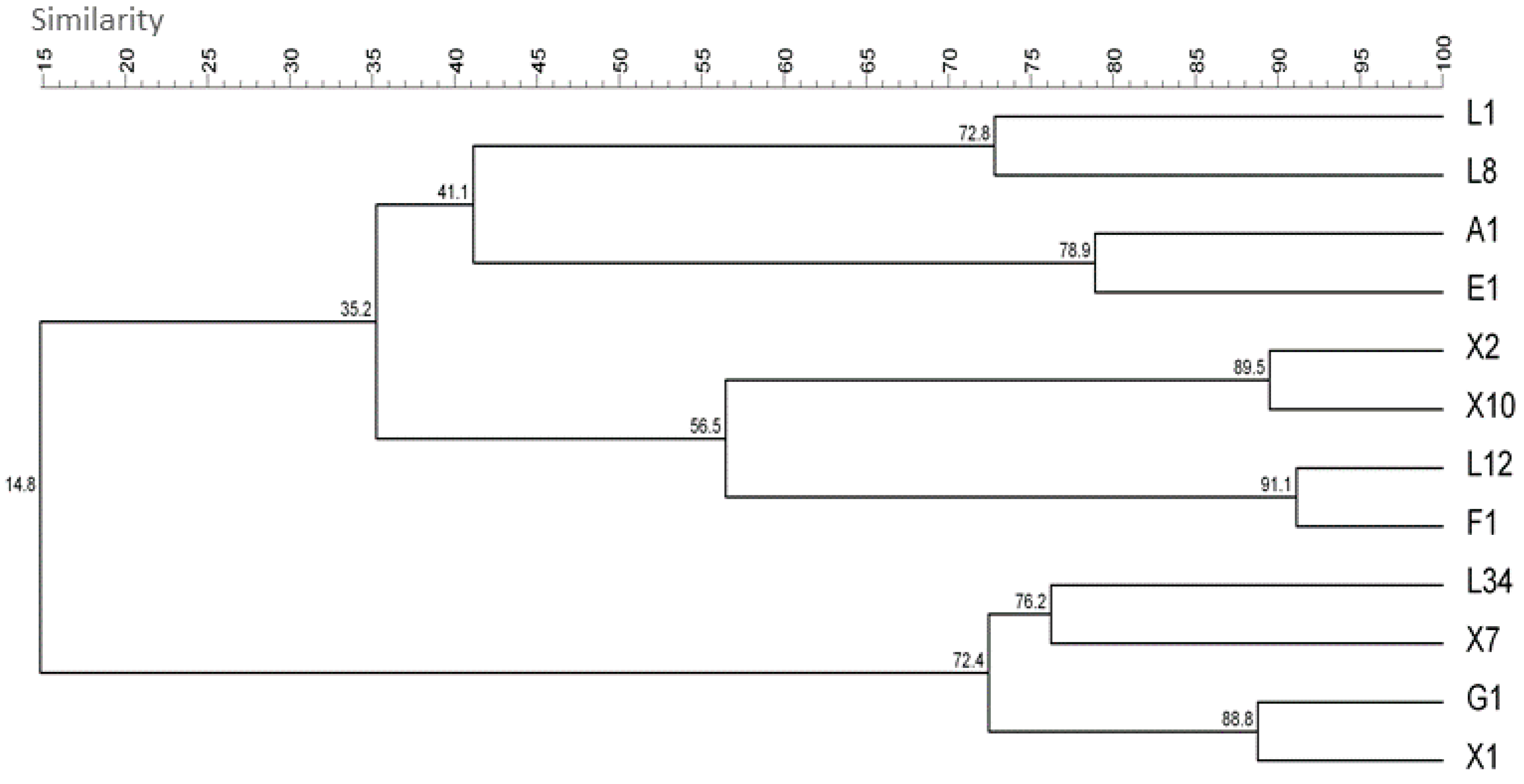
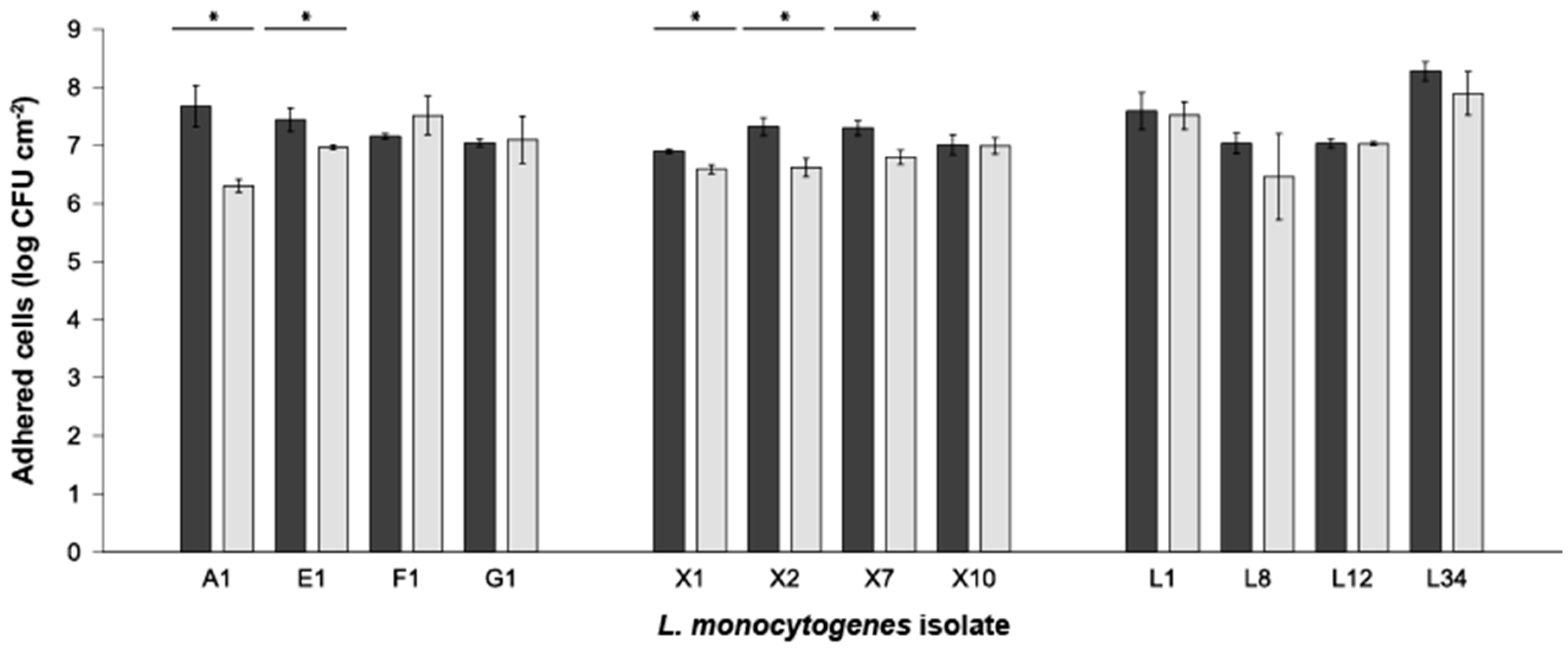
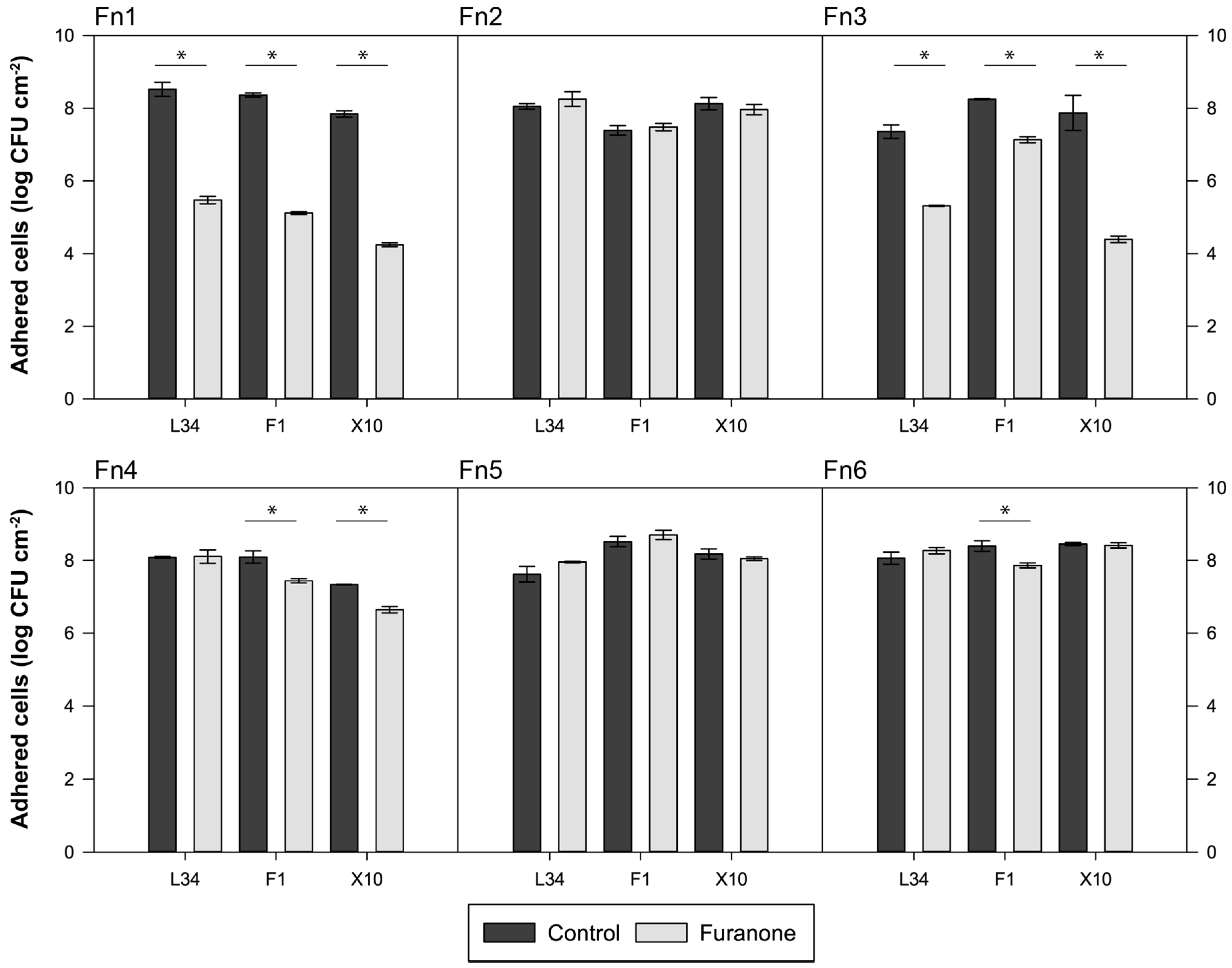

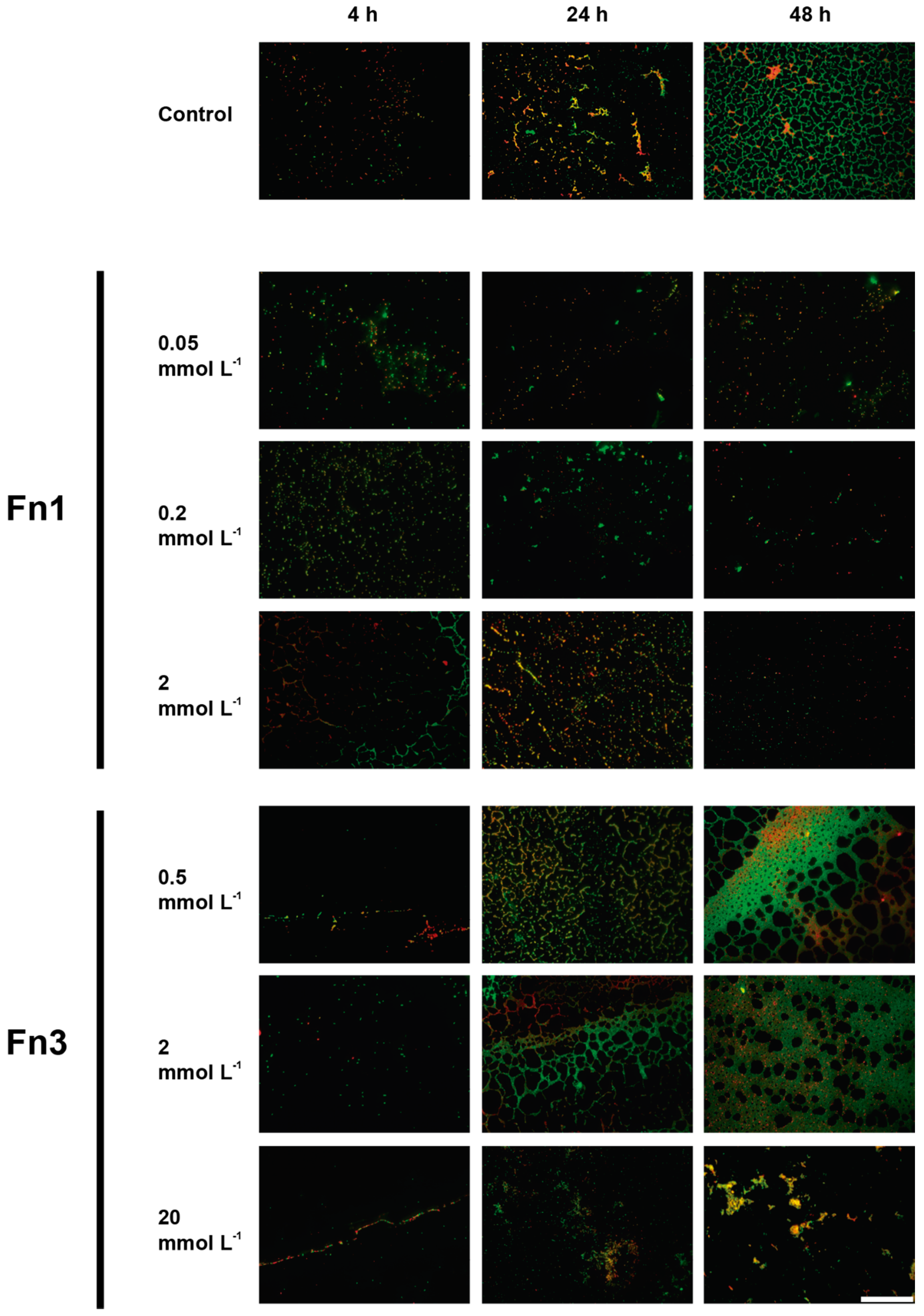
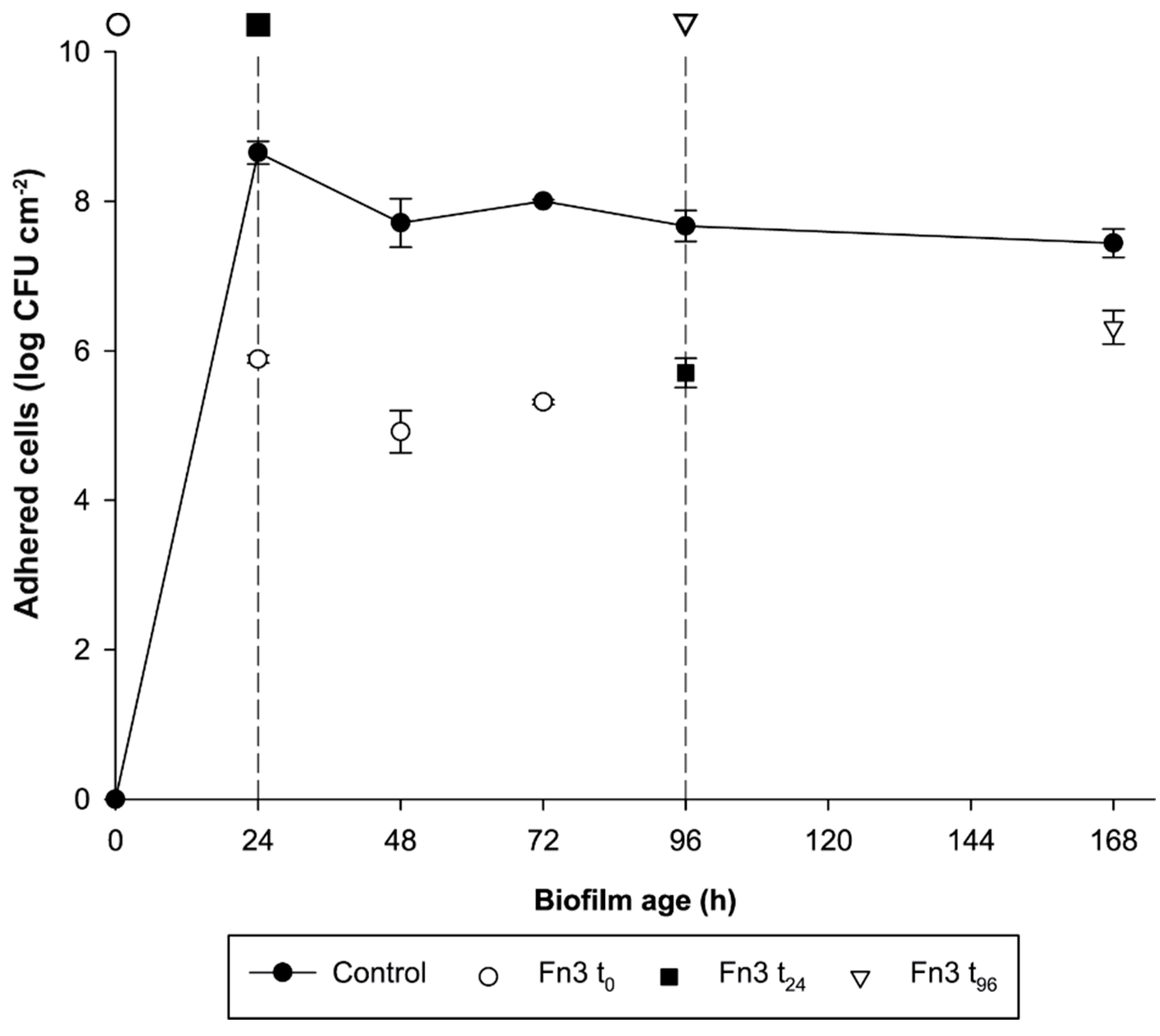
| Source | Code | Origin | Reference |
|---|---|---|---|
| Environmental | A1 | Thermal gloves | [28] |
| E1 | Transportation trolley | [28] | |
| F1 | Meat mincer | [28] | |
| G1 | Milking device | [29] | |
| Food | L1 | Crab salad | [30] |
| L8 | Deli tuna salad | [30] | |
| L12 | Halibut fillet | This study | |
| L34 | Frozen panga fillet | [30] | |
| Clinical | X1 | Human listeriosis | This study |
| X2 | Human listeriosis | This study | |
| X3 | Human listeriosis | This study | |
| X7 | Human listeriosis | This study | |
| X10 | Human listeriosis | This study |
| Code | Furanone Name (Synonym) | Empirical Formula | Structure |
|---|---|---|---|
| Fn1 | (Z-)-4-Bromo-5-(bromomethylene)-2(5H)-furanone (Furanone C-30) | C5H2Br2O2 |  |
| Fn2 | 2-Methyltetrahydro-3-furanone | C5H8O2 |  |
| Fn3 | 3,4-Dichloro-2(5H)-furanone | C4H2Cl2O2 |  |
| Fn4 | 4-Hydroxy-2,5-dimethyl-3(2H)-furanone (Furaneol) | C6H8O3 |  |
| Fn5 | Dihydro-3-amino-2-(3H)-furanone | C4H7NO2 |  |
| Fn6 | (S)-(+)-Dihydro-5-(hydroxymethyl)-2(3H)-furanone | C5H8O3 |  |
© 2019 by the authors. Licensee MDPI, Basel, Switzerland. This article is an open access article distributed under the terms and conditions of the Creative Commons Attribution (CC BY) license (http://creativecommons.org/licenses/by/4.0/).
Share and Cite
Rodríguez-López, P.; Barrenengoa, A.E.; Pascual-Sáez, S.; Cabo, M.L. Efficacy of Synthetic Furanones on Listeria monocytogenes Biofilm Formation. Foods 2019, 8, 647. https://doi.org/10.3390/foods8120647
Rodríguez-López P, Barrenengoa AE, Pascual-Sáez S, Cabo ML. Efficacy of Synthetic Furanones on Listeria monocytogenes Biofilm Formation. Foods. 2019; 8(12):647. https://doi.org/10.3390/foods8120647
Chicago/Turabian StyleRodríguez-López, Pedro, Andrea Emparanza Barrenengoa, Sergio Pascual-Sáez, and Marta López Cabo. 2019. "Efficacy of Synthetic Furanones on Listeria monocytogenes Biofilm Formation" Foods 8, no. 12: 647. https://doi.org/10.3390/foods8120647
APA StyleRodríguez-López, P., Barrenengoa, A. E., Pascual-Sáez, S., & Cabo, M. L. (2019). Efficacy of Synthetic Furanones on Listeria monocytogenes Biofilm Formation. Foods, 8(12), 647. https://doi.org/10.3390/foods8120647







